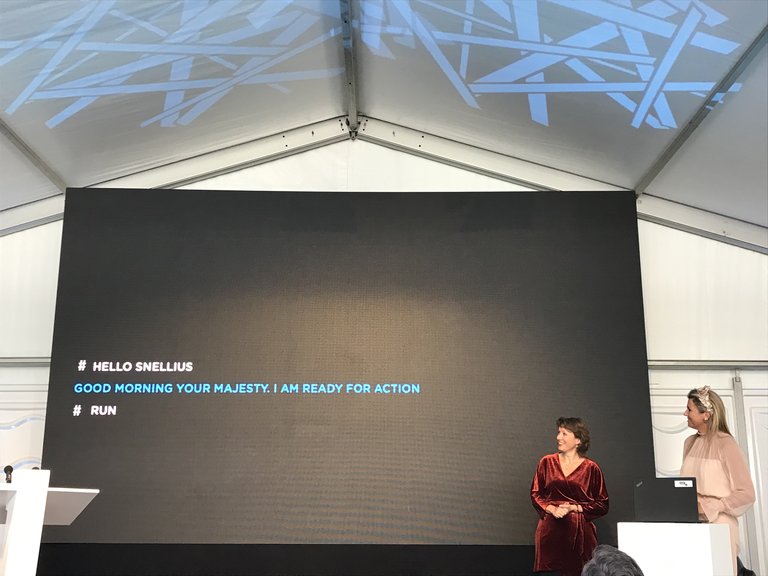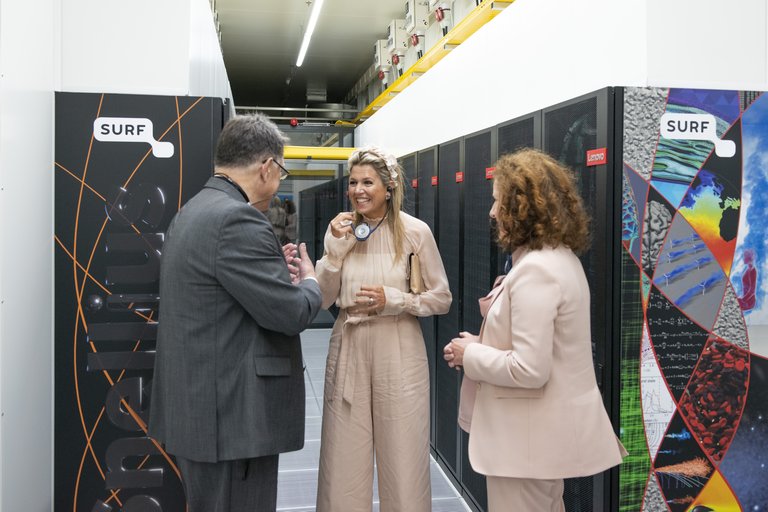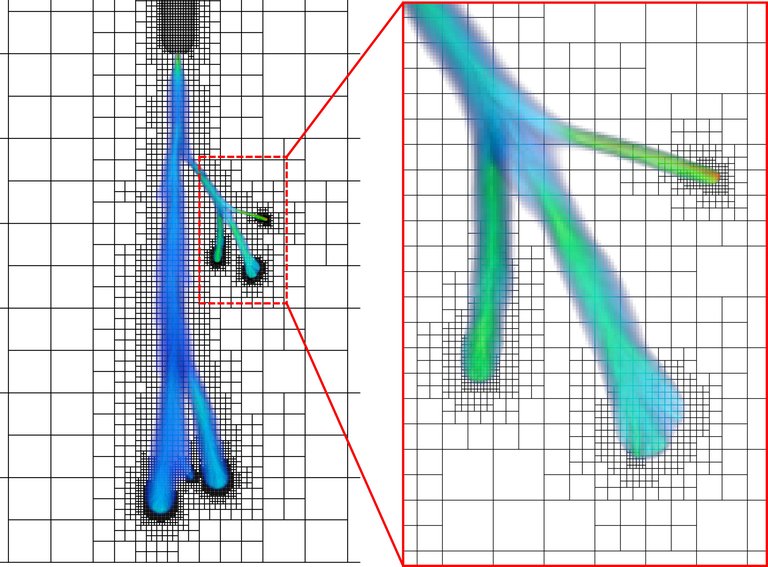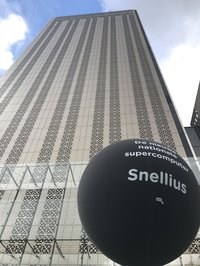On Thursday 16 September, Queen Máxima performed the official opening of the new national supercomputer Snellius, ten times more powerful than its predecessor. All researchers at Dutch universities and research institutes will be able to use it. This longread tells about how CWI researchers have relied on this powerful machine since the purchase of the first national supercomputer in 1984: from testing security keys to simulating gas and liquid flows and electrical discharges.

Supercomputer Snellius in brief
- Name: Willebrord Snellius was a 17th century Dutch mathematician, known for Snellius' refractive law.
- Hardware: Lenovo ThinkSystem servers with AMD EPYC™ processors (the latest generation, 7H12, and a future generation), and the latest generation NVIDIA GPUs (A100).
- Calculation speed: Snellius: 13-21 petaflop (predecessor Cartesius: 1.8 petaflop)
- Peak power: 1 MegaWatt
- Location: Amsterdam Data Tower, Amsterdam Science Park.
- Purchased and managed by SURF (the collaborative organization for ICT in Dutch education and research)
- Costs: 18 million euros paid by the Ministry of Education, Culture and Science (via NWO) and 2 million euros from SURF's own funds.

"Our CWI computers are quite nice, but they cannot match the national supercomputer," says CWI researcher Jannis Teunissen from Ute Ebert's Multiscale Dynamics group. "And so it is great that we can rely on such a fast, external supercomputer. With more computing power we get closer and closer to reality."
A handful of CWI researchers regularly compute on the national supercomputer. In the past eight years, this was the Cartesius, but from now on it will be the Snellius, which is roughly a factor of ten faster. Teunissen and his colleagues mainly perform calculations on electrical discharges, also known as a plasma, a gas in which the electrons are partially separated from the atoms, causing the gas to become ionised.
Teunissen: "Plasmas have all kinds of practical applications. For example, water activated with a plasma can be used to disinfect agricultural crops. The big advantage is that this method of disinfection does not damage the environment because the potentially harmful chemical components disintegrate fairly quickly through plasma activation and become harmless."

Another application lies in the field of high voltage technology, Teunissen explains. "When you want to interrupt a large electrical current, an electrical discharge often occurs, creating a plasma. The better we understand that process, the better we can design equipment that can switch such currents. A commonly used gas for this application, SF6, will have to be replaced in the coming years because it is an extreme greenhouse gas, which poses new challenges."
Counterintuitive insights
Teunissen expects that by the end of 2021, he and his CWI colleagues will have made full use of the Snellius and learned new things about one of the major challenges in their research: "The electrical discharges that we study give rise to complex branching structures, a kind of channels. A long-standing question is what exactly determines these structures. To find out, you need 3D simulations, which we want to do with Snellius. We have already done exploratory calculations on Cartesius and we will continue them on Snellius."
Calculating on a faster supercomputer provides much more than solving a large computational problem faster. It can also lead to new insights. "The beauty of simulations," Teunissen concludes, "is that I am often surprised by the results. As a researcher, you have a certain intuition about the solution to a problem, but it often happens that the simulation shows that your intuition is wrong. Then you get a new insight that you wouldn't have gotten without a simulation or would have been much harder to get."

Simulating fluid flows
The new national supercomputer Snellius has been purchased by SURF (the collaborative organisation for ICT in Dutch education and research) for the entire Dutch scientific community. Walter Lioen is Head of Research Services at SURF, which also includes the High Performance Computing and Visualisation team that manages the Snellius and supports users. Between 1985 and 2001 he worked as a scientific programmer at CWI in the Numerical Mathematics group of Herman te Riele, a group that made frequent use of the national supercomputer (see the box 'Safe with large numbers thanks to CWI work' at the end).
Lioen's entire professional career is linked to the national supercomputer, first as a technician with a background in numerical mathematics and then as a manager. "What I personally liked most about working with the national supercomputer as a programmer was to get top performance from that machine," he says. "This places high demands on the way you program the supercomputer."
Lioen: "The scientific work we did with the supercomputer in my years at CWI ranged from simulating tidal movements and the drying up of sandbanks in the North Sea, simulating air currents around aircraft wings, calculating atmospheric models, to numerical theoretical work in Herman te Riele's group."
Another job Lioen worked on with others at CWI was the creation of a so-called numerical library for working on the national supercomputer, called NUMVEC. This type of work has a long history at CWI, dating back to programming in Algol in the 1960s, when the numerical library NUMAL was created. Lioen: "The goal of our numerical library NUMVEC was to optimise the implementation of numerical algorithms on the national supercomputer so that we could calculate as efficiently as possible."
Artificial Intelligence
One of the new features that Snellius offers compared to its predecessor is that it is much more suitable for running machine learning models, which are now widely used in artificial intelligence. Lioen: "You can think of the scientific development of new machine learning models or of running machine learning applications. This can also be very interesting for CWI, because machine learning is being used for more and more scientific problems. Exactly what researchers will do with Snellius is up to them. If they have a nice use case in mind, they can apply for computing time."
If all goes according to plan, Snellius will be ready for scientific use in the course of October and should last about five years before it is time to buy another more powerful national supercomputer.

Safe with large numbers thanks to CWI work
If you do your banking via a secure website, you automatically make use of digital security based on so-called RSA cryptography (named after the inventors Rivest, Shamir and Adleman). RSA cryptography is based on the improbability of quickly factorising numbers of a few hundred digits into their two big prime divisors.
With small numbers, factorisation is easy, as with the number 15 for example. This number has as prime divisors the two prime numbers 3 and 5, because 3 × 5 = 15. But the larger the number, the more difficult it becomes to find prime divisors, even for high-speed computers. RSA uses large numbers as security keys to encrypt a message. The security is designed so that a malicious person can only decrypt the message if he knows the two big prime divisors.
To test the reliability of digital security and to determine new standards, mathematicians use a supercomputer to try to factorise ever-larger numbers into prime divisors. The supercomputer calculates products of a lot of combinations of two big prime numbers until it finds the right one. In the past decades, CWI researchers have made important contributions to testing RSA to its limits. In 1999, they contributed to the breaking of the RSA-512 security standard and in 2010 to the breaking of RSA-768.
CWI researcher Herman te Riele (retired at the beginning of 2021) and his colleagues spent many years computing on the national supercomputer, which means on predecessors of Snellius. In 2009 he wrote about in the article 'Cryptography and supercomputers' (published in the book 'De Rekenmeesters - A forward-looking picture of 25 years of large-scale computing in the Netherlands', P. Michielse (ed.)):
"Over the past fifteen years [1994-2009], CWI researchers, including five PhD students, have also made extensive use of SARA supercomputers to factor numbers that were very large, but slightly below record size, for a variety of purposes. In addition to cryptography, the problem of factorising large numbers also plays a role in various number-theoretic problems. The efforts of CWI researchers in factorising very large numbers and thereby validating RSA [an important encryption method] have contributed significantly to the current standard for choosing the RSA key length in practice. The help of SARA supercomputers was crucial in this process."
More information
- SURF-podcast (in Dutch) about Snellius
- TV reportage by EenVandaag (in Dutch) about Snellius
- Tweakers made in 2016 a historical overview of all the Dutch national supercomputers
- Tweakers also wrote in more technical detail about Snellius
